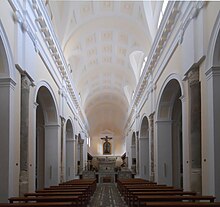Gaeta Cathedral
The Cathedral of Gaeta or the Cathedral of the Assumption and St. Erasmus ( Italian Cattedrale dei Santi Erasmo e Marciano e di Santa Maria Assunta ) is a church in Gaeta in the Italian region of Lazio . The cathedral of the Archdiocese of Gaeta is dedicated to the Assumption of Heaven and Erasmus of Antioch and has the rank of minor basilica . The cathedral, which is today baroque , has been significantly redesigned several times, the size of the church, the number of naves and the orientation have been changed.
history
The small church of Santa Maria del Parco from the 7th century, located near the port, became the first cathedral after the transfer of the bishopric from Formia to Gaeta in the 9th century, where the relics of Saint Erasmus and other martyrs were also moved. Their rediscovery in 917 led to expansion or renovation work on the cathedral, which was consecrated in 1106 by Pope Paschal II (1099–1118) to the Blessed Virgin Mary's Assumption and to Saint Erasmus. This second Romanesque cathedral is said to have had the shape of a patriarchal cross with seven naves and six rows of marble columns, which were partially exposed during the restoration in 2014. Between 1148 and 1279, the 57-meter-high Moorish bell tower , which still exists today, was built. After the earthquake of 1231, the complex was modified several times with the support of Pope Alexander IV (1254–1261), including the restoration of the Gothic vaults with pointed arches. The facade of the building should originally have faced the sea and was adjacent to the bell tower. The construction of the seven naves is also believed to be a reconstruction after the earthquake of 1349, without there being any documents.
In the 17th century, with the construction of the crypt between 1620 and 1644 by Giacomo and Dionisio Lazzari for the bones of the saints, the church received a Baroque redesign with frescoes by Giacinto Brandi (1662–1664) about St. Erasmus. With the new crypt, the orientation of the cathedral was reversed and the choir expanded, which received wooden choir stalls and in 1683 an altar made of polychrome marble.
Between 1788 and 1793 the building was completely renovated, reducing the number of naves to three divided by two rows of six brick columns. The complex was completed by a raised transept that led into the choir. The cathedral was rededicated on May 28, 1793. In 1903, on the 1600th anniversary of the martyrdom of Saint Erasmus, a new facade in neo-Gothic style was built. In 1848 the diocese was founded by Pope Pius IX. raised to the archdiocese and the cathedral to the minor basilica.
The Second World War caused considerable damage to the cathedral: on the night of September 8th to 9th, 1943, a bomb exploded in the choir room. Many works of art as well as parts of the frescoes were lost. The cathedral was restored between 1946 and 1950 and consecrated on November 23, 1950. New major restorations were carried out between 2009 and 2014, illustrating the many stages in the construction of the cathedral.
Web links
- Website of the Basilica Cattedrale di Gaeta (Italian)
- Chiesa di Maria Assunta in Cielo on BeWeB (Italian)
Individual evidence
- ^ Basilica Cattedrale di Santi Erasmo e Marciano e Maria SS. Assunta on gcatholic.org
Coordinates: 41 ° 12 ′ 31.3 " N , 13 ° 35 ′ 12.5" E


